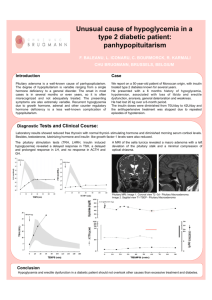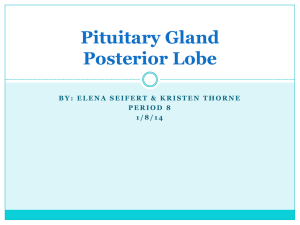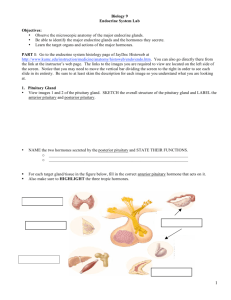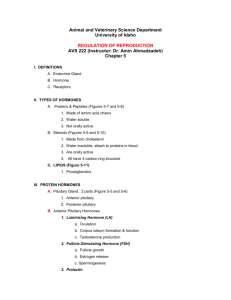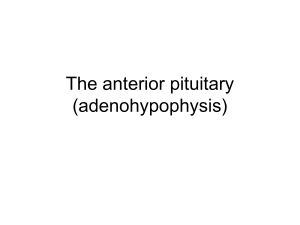Week 2 Endocrine Anatomy and Physiology review & Pituitary
advertisement
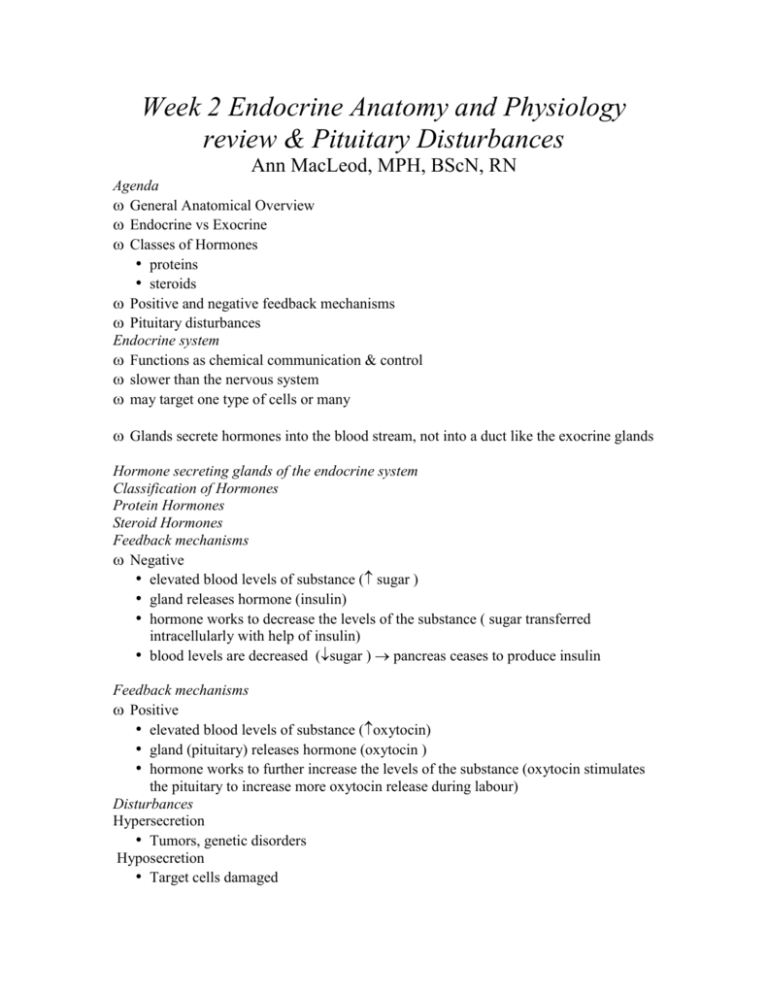
Week 2 Endocrine Anatomy and Physiology review & Pituitary Disturbances Ann MacLeod, MPH, BScN, RN Agenda General Anatomical Overview Endocrine vs Exocrine Classes of Hormones • proteins • steroids Positive and negative feedback mechanisms Pituitary disturbances Endocrine system Functions as chemical communication & control slower than the nervous system may target one type of cells or many Glands secrete hormones into the blood stream, not into a duct like the exocrine glands Hormone secreting glands of the endocrine system Classification of Hormones Protein Hormones Steroid Hormones Feedback mechanisms Negative • elevated blood levels of substance ( sugar ) • gland releases hormone (insulin) • hormone works to decrease the levels of the substance ( sugar transferred intracellularly with help of insulin) • blood levels are decreased (sugar ) pancreas ceases to produce insulin Feedback mechanisms Positive • elevated blood levels of substance (oxytocin) • gland (pituitary) releases hormone (oxytocin ) • hormone works to further increase the levels of the substance (oxytocin stimulates the pituitary to increase more oxytocin release during labour) Disturbances Hypersecretion • Tumors, genetic disorders Hyposecretion • Target cells damaged • Receptors on target cells malfunctioning • damaged gland due to age, injury, genetics see table in handout or pg 1030 in Brunner Hypothalmus affects Pituitary Anterior Pituitary: Hypothalmus secretes releasing hormones for the following: TSH Thyroid growth ACTH Adrenal cortex homeostasis FSH ovary/seminiferous sexual dev’p LH ovary & egs/testes estrogrogen/ testosterone fertile GH all organs blood glucose used for growth (somatotropin) Prolactin Breast tissue milk production Hypothalmus affects Pituitary Posterior Pituitary directly stimulated by neurohormones released from the hypothalmus ADH(vasopressin) kidney H2O retention/diuresis Oxytocin milk ducts and uterine muscle contraction Posterior pituitary Pituitary Gland Disturbances of the Anterior Pituitary : Hyposecretion Hypopituitarism May result from the pituitary gland itself or from a disease of the hypothalmus however, the result is the SAME may occur d/t radiation to the head and neck, trauma, tumors, vascular lesions Dwarfism Hypo secretion of GH, TSH, FSH, LH, ACTH metabolic dysfuction sexual immaturity growth retardation causes: tumors, congenital defects, pit. Ischemia, radiation, surg, brain injury, chemical agents Dwarfism May be perm. Or reversible, the gland may be 75% dysfunctional before you see findings Assessment: Delayed puberty obesity fine scant hair small bones Loss of libido decreased body temp decreased resistance to colds and infection small stature delayed growth according to scales Disturbances of the Anterior Pituitary : Hypersecretion ACTH Cushings’s syndrome ( cover during adrenal cortex discussion) GH acromegaly & giantism Assessment findings Excessive growth of bones and soft tissues enlargment of facial features, tongue, and viscera Skin is warm, moist, coarse and oily Diagnostic Tests Skull x-ray may show enlarged pituitary gland CT/MRI: shows thick long bones Blood work: may indicate Increased prolactin, GH, and ACTH urine: hypo: decreased cortisol, gonadotropin, decreased GH Management: Hormone replacement therapy is nec. For hyposecretion that isn’t r/t pit. Tumours Hormone suppression therapy for hormone secreting tumors ie. Parlodel: inhibits the synthesis and release of ant. Pit. Hormones by the gland Surgery Hypophysectomy: Rx. Of choice for pituitary tumors transphenoidal: entry is gained through the inner aspect of upper lip through the sphenoid sinus Post -op hypophysectomy Monitor LOC measure I+O assess for hemorrhage inspect nasal packing for blood and CSF monitor for excess swallowing (hemorrhage) Avoid nose blowing, HT: may lose sense of smell monitor for edema watch for addisons disease and thyroid problems replacement hormones are for life Posterior Pituitary lobe hyposectretion Diabetes insipidus: deficient production of vasopressin, kidneys excrete large amounts of urinedue to trauma, tumors infections or renal tubules don’t respond to ADH Posterior Pituitary lobe hyposectretion Assessment & Management Urine SG 1.001-1.005 4-40 litres Desmopressin DDAVP synthetic vasopressin (nasal spray) IM Vasopressin


